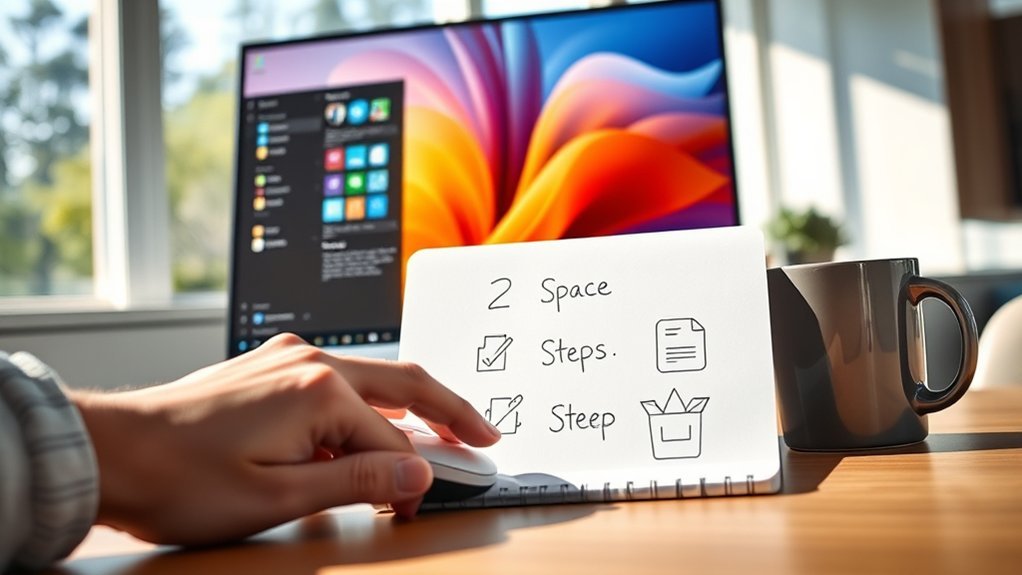Clearing cache on Windows 11 can help free up valuable space and improve system performance. By following five straightforward steps, you can easily manage temporary files and optimize your device. From using the Disk Cleanup tool to automating tasks with Storage Sense, these methods are effective and user-friendly. Plus, resetting the Microsoft Store cache and maintaining your browser cache will further enhance your experience. Let’s explore these steps in detail to maximize your system’s efficiency.
Accessing Disk Cleanup Tool
To clear cache on Windows 11, you’ll first need to access the Disk Cleanup tool.
Click on the Start menu and type “Disk Cleanup” into the search bar. Select the Disk Cleanup app from the results.
Once it opens, choose the drive you want to clean—typically, this will be the C: drive where your operating system is installed. Click “OK.”
The tool will take a moment to calculate how much space you can free up. After that, a list of files will appear.
You can check the boxes next to the items you want to remove, such as temporary files and system cache.
Finally, click “OK” to initiate the cleanup process and reclaim valuable storage space.
Clearing Temporary Files
Clearing temporary files helps free up valuable disk space and can enhance your system’s performance. These files accumulate over time, and removing them is a straightforward way to optimize your PC. Here’s a quick reference to the types of temporary files you can clear:
| File Type | Purpose | Recommended Action |
|---|---|---|
| Browser Cache | Stores web pages for quick access | Clear regularly |
| System Cache | Helps apps run faster | Clear when slow |
| Installation Files | Leftovers from software installs | Delete after use |
| Log Files | Records system events | Clear periodically |
| Error Reports | Details of system errors | Review and delete |
Using Storage Sense
After you’ve cleared temporary files, consider using Storage Sense to maintain your system’s performance.
This built-in tool automatically frees up space by removing unnecessary files, such as those in your Recycle Bin or Downloads folder.
To enable Storage Sense, go to Settings, then System, and select Storage. Toggle on Storage Sense and customize how often you want it to run—daily, weekly, or monthly.
You can also decide what types of files to delete, giving you control over your storage.
By letting Storage Sense do the heavy lifting, you’ll keep your system running smoothly without the hassle of manual cleanup.
Embrace this feature for a streamlined experience that liberates your device from clutter.
Clearing Browser Cache
While browsing the internet, your browser accumulates cache files that can slow down performance or cause display issues.
To clear your browser cache, open your browser settings. For Chrome, click on the three dots in the upper right corner, select “More tools,” and then “Clear browsing data.” Choose the time range and make certain you select “Cached images and files.”
In Firefox, go to the menu, select “Options,” then “Privacy & Security,” and click on “Clear Data.”
For Edge, click on the three dots, navigate to “Settings,” choose “Privacy, search, and services,” and select “Choose what to clear.”
Regularly clearing your cache helps maintain a smooth browsing experience and keeps your online activities efficient and enjoyable.
Resetting Microsoft Store Cache
To reset the Microsoft Store cache, you can use a simple command that helps resolve issues like slow loading times or download errors.
Just press the Windows key + R to open the Run dialog. Type `wsreset.exe` and hit Enter. This command clears the cache without affecting your installed apps.
You’ll see a blank Command Prompt window briefly open, and then the Microsoft Store will launch automatically.
After that, you should notice improved performance when downloading or updating apps. This quick reset can free you from frustrating issues, allowing you to enjoy a smoother experience in the Store.
Frequently Asked Questions
How Often Should I Clear My Cache on Windows 11?
You should clear your cache regularly—about once a month or whenever you notice slowdowns. This practice keeps your system running smoothly and guarantees you’re not storing unnecessary data that clutters your device.
Will Clearing Cache Delete My Saved Passwords?
No, clearing your cache won’t delete your saved passwords. While it removes temporary files, your passwords stay intact. It’s like decluttering your space without losing your favorite belongings—refreshing without sacrificing what matters.
Can Cache Clearing Improve My Computer’s Speed?
Yes, clearing cache can improve your computer’s speed. It frees up storage space and removes outdated files, allowing your system to run more efficiently. Regular maintenance helps keep your device responsive and optimized for performance.
Is There a Way to Automate Cache Clearing?
You can automate cache clearing by using built-in tools or third-party software. Imagine your computer breathing easier! Set scheduled tasks to keep it running smoothly, freeing you from manual cleanup and ensuring peak performance effortlessly.
What Happens if I Accidentally Clear Important Cache Files?
If you accidentally clear important cache files, you might lose saved preferences or temporary data, causing apps to run slower initially. However, they’ll usually rebuild the cache over time, restoring functionality with minimal disruption.
Conclusion
In the words of Benjamin Franklin, “A penny saved is a penny earned.” By following these five steps to clear cache on Windows 11, you’re not just freeing up space but also boosting your system’s performance. Regularly accessing the Disk Cleanup tool, utilizing Storage Sense, and managing your browser cache will keep your device running smoothly. Don’t wait—make these practices a habit and enjoy a cleaner, faster Windows experience!

